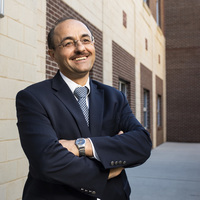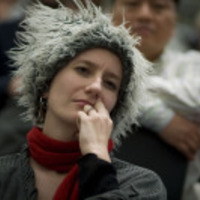
Tim Hutchings
My PhD thesis, "Creating Church Online" (Durham University, 2010), was an ethnographic study of five Christian communities. Each church met online, using new media to create forms of worship, teaching, evangelism and debate.
My subsequent research has included studies of a wide range of religious uses of new media, including proselytism and disaffiliation, digital pilgrimage, the Bible as a digital text and digital grief.
Since 2012, I have been the Editor of the Journal of Religion, Media and Digital Culture, an online, open-access, peer-reviewed journal for social-scientific research in the field of digital religion. For more information, visit brill.com/rmdc. RMDC has been published by Brill since 2018 as the partner journal of the International Society for Media, Religion and Culture.
Supervisors: Dr Mathew Guest
Address: Theology and Religious Studies
School of Humanities
University Park
Nottingham
NG7 2RD
My subsequent research has included studies of a wide range of religious uses of new media, including proselytism and disaffiliation, digital pilgrimage, the Bible as a digital text and digital grief.
Since 2012, I have been the Editor of the Journal of Religion, Media and Digital Culture, an online, open-access, peer-reviewed journal for social-scientific research in the field of digital religion. For more information, visit brill.com/rmdc. RMDC has been published by Brill since 2018 as the partner journal of the International Society for Media, Religion and Culture.
Supervisors: Dr Mathew Guest
Address: Theology and Religious Studies
School of Humanities
University Park
Nottingham
NG7 2RD
less
Related Authors
James Elkins
School of the Art Institute of Chicago
Naim Kapucu
University of Central Florida
Don Ross
University College Cork
Paul Levinson
Fordham University
Michele A Willson
Curtin University
danah boyd
Microsoft Research
Benjamin Isakhan
Deakin University
Elise Dermineur
Stockholm University
Cristiana Facchini
Università di Bologna
Radhika Gajjala
Bowling Green State University
InterestsView All (40)










Uploads
Papers by Tim Hutchings
to engage with the Bible through the screen and speakers of his/her
mobile phone, tablet or computer. Both products, ‘YouVersion’ and
‘GloBible’, have been created by Evangelical Christian companies. I
argue that both are designed to train the user in traditional Evangelical
Christian understandings of the work of reading. Digital media offer
new opportunities to guide and influence the user, and this article
applies the concepts of ‘persuasive technologies’ and ‘procedural
rhetoric’ to analyse the design intentions of the two digital Bibles.
This approach helps us to appreciate the significance of the material
form of a sacred text as a vehicle for religious socialisation and
raises important questions about the potential for digital media to
re-shape traditional relationships of power in Evangelical Christian
communities.
through bodily engagement with the material elements of the world’ ( 2015: 3). For Elisabeth Arweck and William Keenan, ‘the idea of religion itself is largely unintelligible outside its incarnation in material expressions’ ( 2006: 2–3). Matthew Engelke goes even further, arguing that ‘all religion is material religion’, to be understood ‘in relation to the media of its materiality’ ( 2012 : 209). But what are these “material elements” or “expressions”? When we study material religion, what is it that we are looking at?
The idea for this book emerged from “Material Religion”, a conference of the BSA’s Sociology of Religion Study Group (Socrel) hosted at Durham University in the spring of 2013. It seems appropriate, then, to begin our introduction with one of Durham’s most famous and disputed examples of the materiality of religion: the body of St Cuthbert, the relic that the city’s vast cathedral was built to contain.
to engage with the Bible through the screen and speakers of his/her
mobile phone, tablet or computer. Both products, ‘YouVersion’ and
‘GloBible’, have been created by Evangelical Christian companies. I
argue that both are designed to train the user in traditional Evangelical
Christian understandings of the work of reading. Digital media offer
new opportunities to guide and influence the user, and this article
applies the concepts of ‘persuasive technologies’ and ‘procedural
rhetoric’ to analyse the design intentions of the two digital Bibles.
This approach helps us to appreciate the significance of the material
form of a sacred text as a vehicle for religious socialisation and
raises important questions about the potential for digital media to
re-shape traditional relationships of power in Evangelical Christian
communities.
through bodily engagement with the material elements of the world’ ( 2015: 3). For Elisabeth Arweck and William Keenan, ‘the idea of religion itself is largely unintelligible outside its incarnation in material expressions’ ( 2006: 2–3). Matthew Engelke goes even further, arguing that ‘all religion is material religion’, to be understood ‘in relation to the media of its materiality’ ( 2012 : 209). But what are these “material elements” or “expressions”? When we study material religion, what is it that we are looking at?
The idea for this book emerged from “Material Religion”, a conference of the BSA’s Sociology of Religion Study Group (Socrel) hosted at Durham University in the spring of 2013. It seems appropriate, then, to begin our introduction with one of Durham’s most famous and disputed examples of the materiality of religion: the body of St Cuthbert, the relic that the city’s vast cathedral was built to contain.
Abstract: In recent years, one of the most dramatic areas of growth in the e-reading marketplace has been the Christian Bible, with more than 100 million copies installed. These digital Bibles are designed and promoted as tools for personal and societal transformation, using techniques of persuasive computing to encourage changes in reading behaviour. This paper will analyse the ways in which these new Bibles perpetuate and destabilize traditional Christian theologies, and consider some of the responses Dr Hutchings has observed among users.
This seminar presentation introduces the results of Dr Hutchings' recent "Digital Pilgrimage Project", including an overview of historical understandings of pilgrimage and a look at a new app created by Dr Hutchings to lead users on a journey around Newcastle and Gateshead in north-east England.
Creating Church Online constructs a rich ethnographic account of the diverse cultures of online churches, from virtual worlds to video streams. This book also outlines the history of online churchgoing, from its origins in the 1980s to the present day, and traces the major themes of academic and Christian debate around this topic. Applying some of the leading current theories in the study of religion, media and culture to this data, Tim Hutchings proposes a new model of religious design in contexts of mediatization, and draws attention to digital networks, transformative third spaces and terrains of existential vulnerability. Creating Church Online advances our understanding of the significance and impact of digital media in the religious and social lives of its users, in search of new theoretical frameworks for digital religion.
Material culture has emerged in recent decades as a significant theoretical concern for the study of religion. This book contributes to and evaluates this material turn, presenting thirteen chapters of new empirical research and theoretical reflection from some of the leading international scholars of material religion. Following a model for material analysis proposed in the first chapter by David Morgan, the contributors trace the life cycle of religious materiality through three phases: the production of religious objects, their classification as religious (or non-religious), and their circulation and use in material culture.
The chapters in this volume consider how objects become and cease to be sacred, how materiality can be used to contest access to public space and resources, and how religion is embodied and performed by individuals in their everyday lives. Contributors discuss the significance of the materiality of religion across different religious traditions and diverse geographical regions, paying close attention to gender, age, ethnicity, memory and politics. The volume closes with an afterword by Manuel Vásquez.